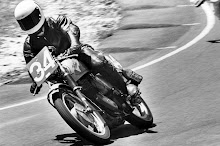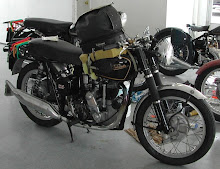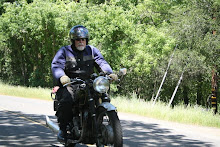Motorcycle travel books have a fascination for me...regular viewers of my blog will recall my wife and my overland trip from Australia in 1974
http://velobanjogent.blogspot.com/2008/04/overland-to-europe-by-motorcycle-in.html
and Robert Fulton Jnr's epic ride in 1932 and written up in his "One Man Caravan" which I reviewed earlier...
http://velobanjogent.blogspot.com/2009/04/one-man-caravanrobert-fulton-jnrs-epic.html
I've many others...."Three Wheeling Through Africa" by J.C.Wilson (1937); "Nansen Passport" by I.S.K.Soboleff (1936); "Across Europe with Satanella" by Claire Sheridan (1925); "From Leipzig to Cabul" by G. Stratil-Sauer (1924);"Around the world with Motorcycle and Camera" by Eitel and Rolf Lange (1953); "Two up by Scooter to Australia" by Michael Marriott (1960); "Three Lands on Three Wheels" by Jan and Cora Gordon (1932); "Australia through the Windscreen" by William Hatfield (1939)...not motorcycling, but interesting anyhow...and the list goes on.
Of course we have the DVD's today of the guys Ewan McGregor and Charley Boorman riding around the world on BMW's...and I may seem sarcastic, but they had a TV cameraman with a backup vehicle , they had mobile 'phones and heaps of support...
So this blog features the first circumnavigation by "road", well if you can call it a road, by Harley Davidson motorcycle and sidecar in 1929 around mainland Australia....
"Around Australia The Hard Way in 1929" written by Jack L. Bowers, one of the two who started out from the GPO in Sydney on 4th July 1929, the other being Frank Oakley Smith ( who had passed away by the time Bowers had his book published in 1995).
I acknowledge the copyright of the book held by Jack L. Bowers....
Left click on the images to enlarge....
Where might you get these books...? If you are lucky some public libraries may have copies , Ebay is a possible source and visiting second hand bookshops and book fairs when you get the chance.
The book I'm reviewing may well be available from the publisher, who's details are on the flyleaf below.
Jack Bowers and Frank Smith set off riding anti clockwise and thus northwards from Sydney....
I'll follow their progress in a generalised view via some of the photographs from Jack's book...
Dinner on the banks of the Barcoo River in Central Queensland.
The road near Cloncurry, Central Western Queensland.
A "general overhaul" at the No.19 bore, Alexandria cattle station, Northern Territory.
The Katherine to Darwin road in 1929 and in 1995....
The finish, 11 weeks later....at the Sydney GPO on 21st September 1929.
A read of the second last page of Jack's book says it all...
In 1958, Sydney motorcyclists Graham Felton and John Sinclair rode a 1942 UL model Harley around Australia, following in Bowers and Smiths wheel tracks.
Then again in 2008 to raise money for Ageing and Alzheimer's disease research they did motorcycle ride using the same outfit from 1958, putting in 11,470km, not quite as far or the same route as their's and Bowers and Smiths route, but an epic anyhow.
I played in a traditional jazz quartet to welcome them back with many others on 20th July 2008.
The cover of the leaflet to promote their latter ride follows....
Hard men all of them.....
Monday, January 31, 2011
Tuesday, January 25, 2011
Motometer...some service/repair information for the BMW R80GS speedometers...
Earlier I started information on the Motometer instruments used on BMW motorcycles, and this is to be continued, as I have yet to cover the BMW K100 and K75 series and the BMW/6 and /7 series.
But this blog deals a bit more technically with problems that arise with the BMWR80GS and a start on the BMW/6 and /7.
Left click on the images to enlarge.....
I had a comment from a chap, "Peter G" who looked at the R80GS blog and I recalled then a common problem that occured with this instrument.
The area where the cable attaches to, and this thread is 18mm x 1.5mm metric, is what we call the lower frame and originally it was supplied as a plastic item..who knows why, but cost is a likely consideration.
With time and heat, the material seemes to change and as the section where the threaded part changes into the main top part of this frame is thin, vibration and road shock would snap it off.
A "quick fix" was to use Araldite or and adhesive, but it seems to not be a permanant repair.
I knew that the frame on the previous BMW/5 models used a diecast metal frame and it was identical, so I used them, but soon ran out of used items.
On a visit to Motometer I enquired as to parts for the BMW/5 intending to purchase these metal frames.
Parts for this model were no longer available, although Motometer admitted to making small batches of the complete instrument for BMW as a spare part.
During the inevitable tour of the factory I noted a pile of these diecast frames and observed the Motometer part number which I quickly wrote down.
Later in Sydney, assembling an order of parts for the later BMW speedos, I included this diecast frame number with a quantity of 100...
I was pleasantly surprised when 6 months later the order arrived and those diecast frames were supplied...Eureka!
I did this a second time before they ceased supply and I note, although I sold all my Motometer parts when I sort of retired to Lionel Otto Instruments in Salisbury, Brisbane, Queensland, I kept three and still have them.
Yes I'll sell them ...email me.
As you can see you need to run the thread further up the diecast frame, as there is a large flat washer and thin nut to secure the speedo into the case.
Another problem that occurs is the bottom of the speedcup shaft which pivots in a bush at the end of the mainshaft where the magnet assembly presses on. This is the same for the GS or the /5/6/7 series instruments.
The end often fractures off, in which case you need to find a supplier of these shafts, or if you've access to a small instrument lathe, Lorch , Emco etc, machine one up out of silver steel.
As well even if they don't fracture they wear...you can feel the wear with the end of your finger..it feels sharp.
Measure the length that this end protrudes from the speedcup bell from the brass centre piece to the end. The range 0.125" -0.140" is what you want and if at the lower end or less, you need to make a locating jig and lightly tap the shaft through.
The magnet is secured to the mainshaft by lightly pressing onto the shaft and trapping a plastic keyplate. Wear occurs on this plastic keyplates bearing surface and so you need to reduce this such that there is minimal play.
Care when pressing the magnet on...make a small pressing piece to push on the brass centre of the magnet to avoid cracking the magnet. DONT tap with a hammer.
It's also possible for the small bush at the top of the mainshaft to wear and it has a small circular hardened piece of steel inder it, called an endplate, which the speedcup shaft mentioned above pivots on.
Re-bushing this is not impossible, but tricky. You need access to a small instrument lathe, a clockmakers Lorch or an Emco 3. You can buy small bushes from clockmaking suppliers, brands such as Bergeon. They are not expensive less than AUD$2 here in Australia and you certainly couldn't machine them up for that.
As well the small threaded top bush...4mm x 0.35mm thread which the speedcup shaft passes through can wear and again a Bergeon bush can effect a repair.
I was able to buy the threaded bushes from Motometer years back.
On the BMW/6 and /7, the mainshaft runs in what looks like a threaded guide, initially brass on the /6, then plastic on the /7. The plastic ones can be used on the /6, but you need to file off the locating webs on the outside.The mainshaft like most of the steel parts in speedometers are unplated metal and thus rust. The rust on the mainshaft causes a squealing noise in operation and cleaning off the rust and regreasing it cures this problem.
The later /7 instruments had a damping bridge and cup arrangement with silicon damping fluid as the medium and reduced the tremor of the pointer in operation.
However pointer trembling or oscillation can also be as a result of an inner drive cable fault....another blog for the future, the care of speedometer cables...or wear in the top and bottom speedcup bushes as well as no damping medium.
Detail of the speedcup shaft bottom pivot length. This wears on the end stone in the bush at the top of the mainshaft and the inside of the aluminium speedcup "poles" on the magnet, eventually destroying it.
You can lightly stone the worn end of the shaft and then tap it though the brass piece in the speedcup to the correct setting...0.140" protruding.
From DQs notebooks...electronic tacho calibration information.
Tuesday, January 18, 2011
A little motorcycle scrapbook from the 1930's...unknown owner, a look at some road racing circuits of the day......
Another small scrapbook I have of motorcycle cuttings from the 1930's that an unknown ( to me) motorcycle enthusiast studiously cut out and pasted into a school exercise book...his passion of the time...did he survive WW2? Is he still alive....questions we will likely never answer...unless, looking at the cover it rings a bell with someone...
The items I've spent considerable time "cleaning up"...newsprint almost 80 years old and not specifically conserved is difficult to work with but fortunately the special A3 sized scanner and programs enable me to get the images to be acceptable, rather than the black and white dotted images if you photocopy....
Left click on the images to enlarge.....
The above is an interesting engine, but more for another day....
This blog is about the road racing circuits of the 1930's...not all, just those that our mystery person collected information on...
The French Grand Prix at Dieppe in 1934.....
The Circuit de Floreffe in Belgium, the 1936 Belgium Grand Prix.
The Monza Grand Prix, Italy
The items I've spent considerable time "cleaning up"...newsprint almost 80 years old and not specifically conserved is difficult to work with but fortunately the special A3 sized scanner and programs enable me to get the images to be acceptable, rather than the black and white dotted images if you photocopy....
Left click on the images to enlarge.....
The above is an interesting engine, but more for another day....
This blog is about the road racing circuits of the 1930's...not all, just those that our mystery person collected information on...
The 1932 Ulster Grand Prix run over the infamous Clady circuit with its 7 mile long, undulating, bumpy "Clady Straight"
The French Grand Prix at Dieppe in 1934.....
The Hohenstein-Ernstthal Grand Prix in Germany in 1937
The 1938 Swiss Grand Prix at Geneva....The Circuit de Floreffe in Belgium, the 1936 Belgium Grand Prix.
The 1932 Spanish Grand Prix at Bilbao.
The German Grand Prix at the Avus circuit, probably 1936....The Monza Grand Prix, Italy
Subscribe to:
Comments (Atom)

























































